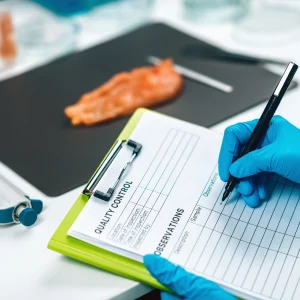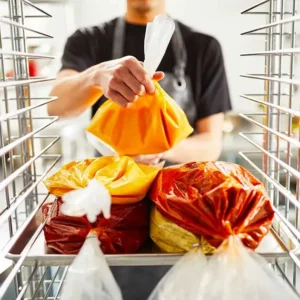Every time you sit down to eat, you’re relying on a complex system designed to protect you. From how ingredients are sourced to how labels are printed, food compliance ensures that what reaches your plate is safe, traceable, and of consistent quality.
What Is Food Compliance?
Food compliance refers to the set of laws, regulations, and standards that govern how food is produced, processed, labeled, stored, transported, and sold.
It’s the foundation of the global food industry. Every factory, restaurant, and supplier must adhere to it, ensuring that food products meet established safety and quality criteria before reaching consumers.
Food safety
Challenge:
-
Ensuring that every ingredient, batch and shipment meets food-safety regulations and quality standards from sourcing through to delivery without slowing down operations.
-
Maintaining accurate, auditable records for temperature during processing, storage and transport in line with frameworks like HACCP, ISO 22000 and the EU Regulation (EC) No 178/2002.
-
Preventing risk of food-borne illness or product spoilage while and this is key keeping supply-chain efficiency.
Why It Matters:
-
Protects consumers: reliable temperature control reduces risks of contamination and spoilage.
-
Builds brand trust: producers and retailers that comply with recognised standards signal safety, consistency and transparency.
-
Enables global trade: alignment with international frameworks (e.g., Codex Alimentarius Commission) facilitates export and cross-border supply-chain operations.
-
Supports sustainability and accountability: modern compliance frameworks often include environmental and ethical dimensions.

Supermarket – cold section
Food Compliance in Europe
Europe is often seen as a benchmark for strong food safety standards. The European Food Safety Authority (EFSA), established in 2002, provides independent scientific advice on all matters relating to food safety.
Regulations like EU Regulation (EC) No 178/2002, known as the General Food Law, lay down the principles of food safety across all member states. It ensures that food placed on the EU market is traceable, labeled correctly, and produced under hygienic conditions.
Key components include:
-
HACCP (Hazard Analysis and Critical Control Points): A preventive system to identify and control food safety risks.
-
Good Manufacturing Practices (GMP): Ensures consistency, cleanliness, and quality in production.
-
ISO 22000: An international standard integrating HACCP principles with management systems.
-
Traceability requirements: The ability to track every ingredient through the supply chain.
Together, these systems create a transparent and harmonized market where safety is non-negotiable.

Trained staff checking regularly on hygiene and documentation.
Global Food Compliance
Food safety doesn’t stop at borders. As international trade grows, countries align their regulations with global frameworks.
The Codex Alimentarius, established by the FAO and WHO, provides a worldwide reference for food standards, labeling, and safety practices. It acts as a foundation for national laws in over 180 countries.
In addition, international certifications such as BRCGS (Brand Reputation through Compliance Global Standards) and FSSC 22000 (Food Safety System Certification) have become vital for businesses that export or supply global retailers.
Regions like North America, Asia, and Oceania have developed their own systems, but all share a common goal: protecting consumers while maintaining fair, transparent trade in food products.
How Businesses Stay Compliant
Achieving compliance means building safety into every step of the process. Successful food businesses typically:
-
Train staff regularly on hygiene, hazard control, and documentation.
-
Maintain detailed records for traceability and audits.
-
Conduct routine internal inspections and third-party audits.
-
Source ingredients only from verified and certified suppliers.
-
Stay informed about changes in national and international food laws.
Compliance is not a one-time requirement it’s a continuous cycle of monitoring, improvement, and accountability.
Stored food

